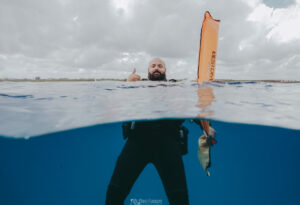Cenotes are among the most incredible places to visit when you come to Mexico, especially if you love diving.
When you dive in a cenote, you discover crystal clear water, stunning light effects, and rock formations with impressive shapes.
No matter your diving level, there’s always a cenote that’s perfect for you.
Here, we explain everything you need to know before diving into a cenote in Mexico.
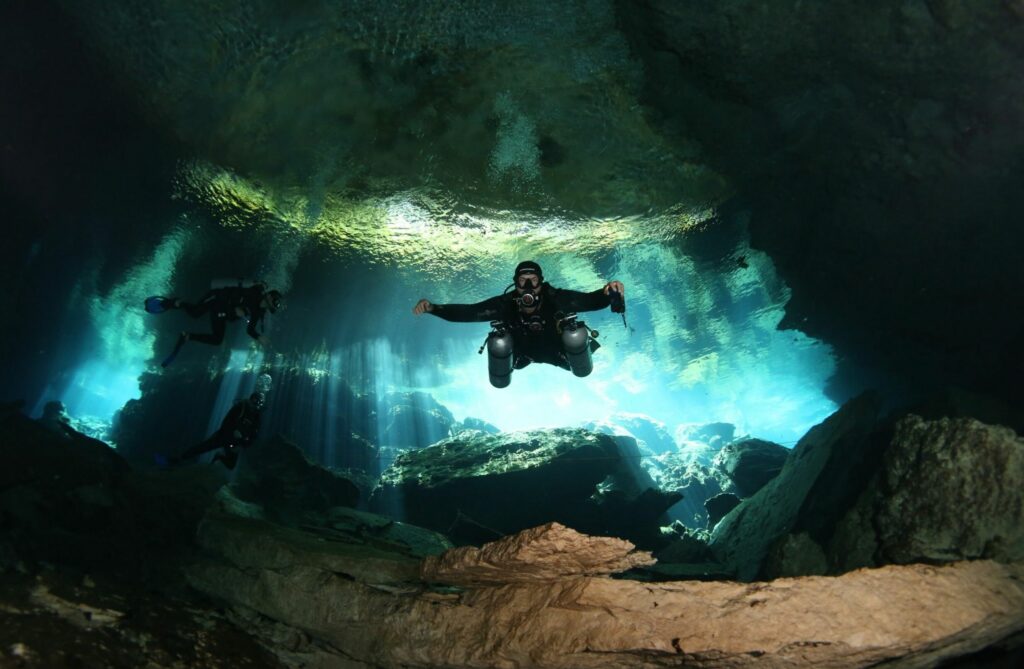
What is a cenote?
A cenote is a natural formation created when limestone bedrock collapses, forming a hole or a cavity filled with fresh water from underground rivers. They are mostly found in karst regions.
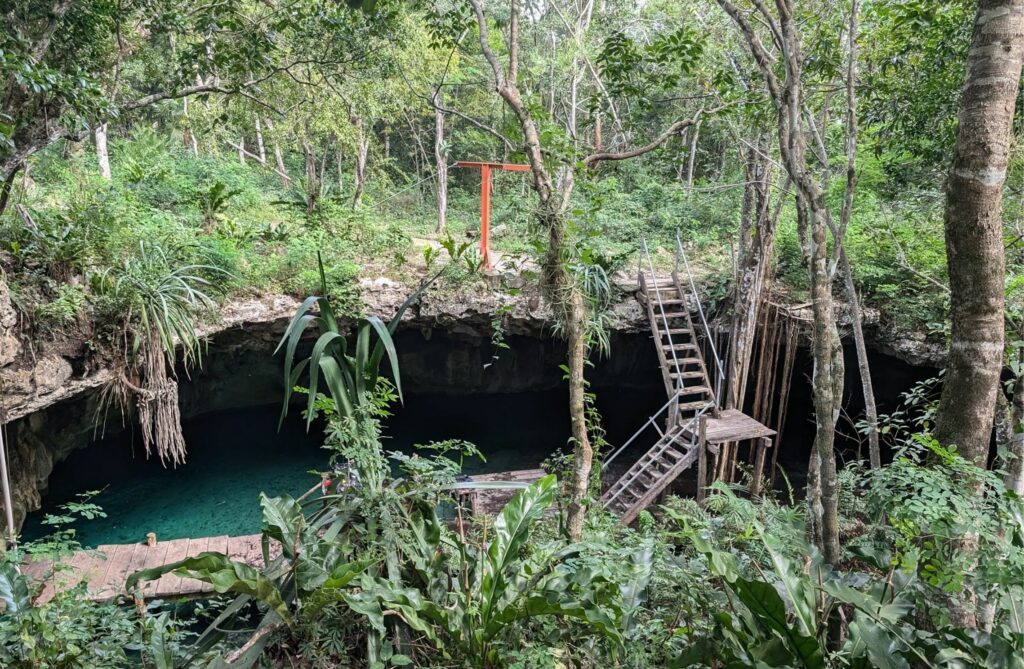
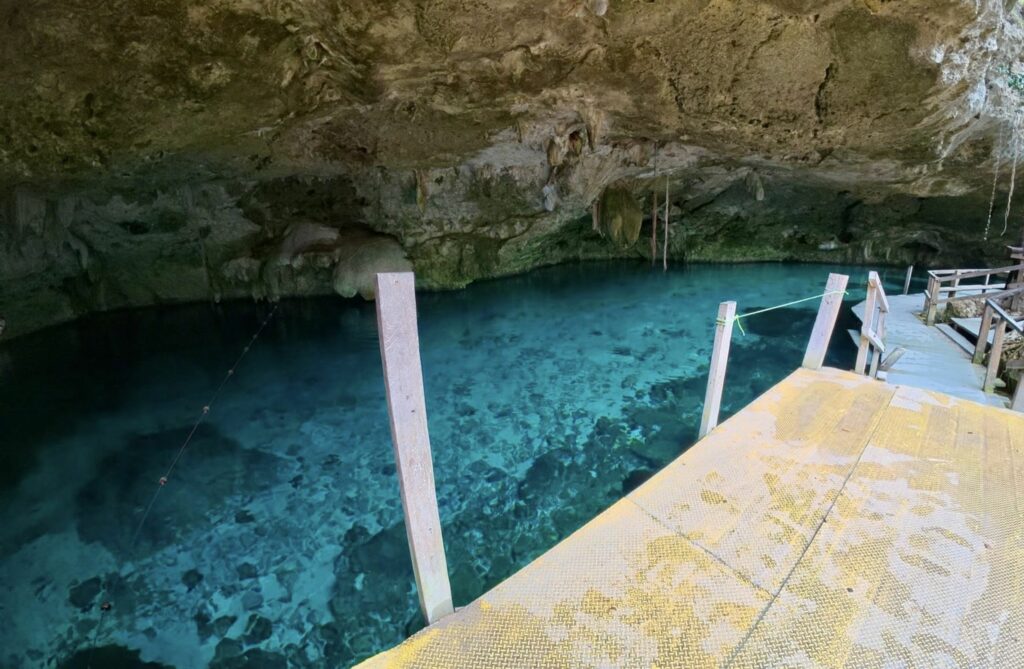
Today, cenotes attract divers, nature lovers, and archaeologists, who have discovered many ancient remains inside them. The word “cenote” comes from the Mayan term dz’onot, which means “sacred well.”
What did cenotes mean to the Mayans ?
For the Mayans, cenotes held a central place, both spiritual and practical. These natural formations were not seen as mere water sources but as gateways to the underworld called Xibalbá, the realm of gods and spirits.
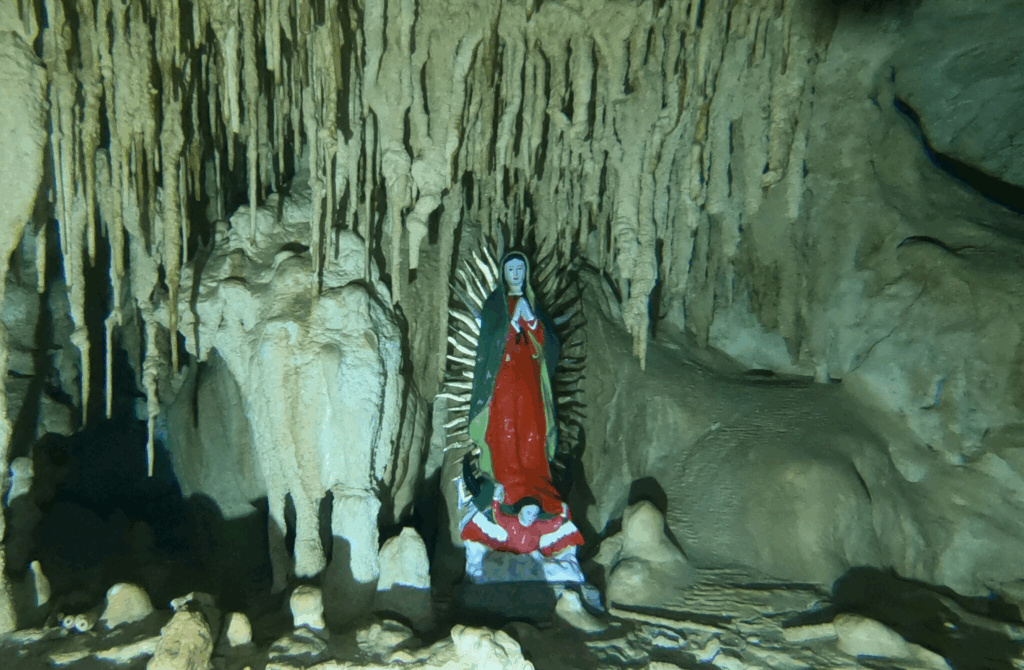
The Mayans held religious ceremonies in cenotes to invoke Chaac, the god of rain, and ensure good harvests.
On a more practical level, cenotes were also essential for daily survival, as they provided the main source of fresh water in a region without surface rivers. It was around these water sources that the Mayans chose to establish many of their cities.
The different types of cenotes in Mexico
Not all cenotes look the same their shape and accessibility depend on their age and the erosion of the limestone ground.
There are mainly three types of cenotes in Mexico :
1. Open cenote
Open cenotes are the oldest ones. Over time, the roof that once covered them has completely collapsed, leaving a wide opening to the sky.
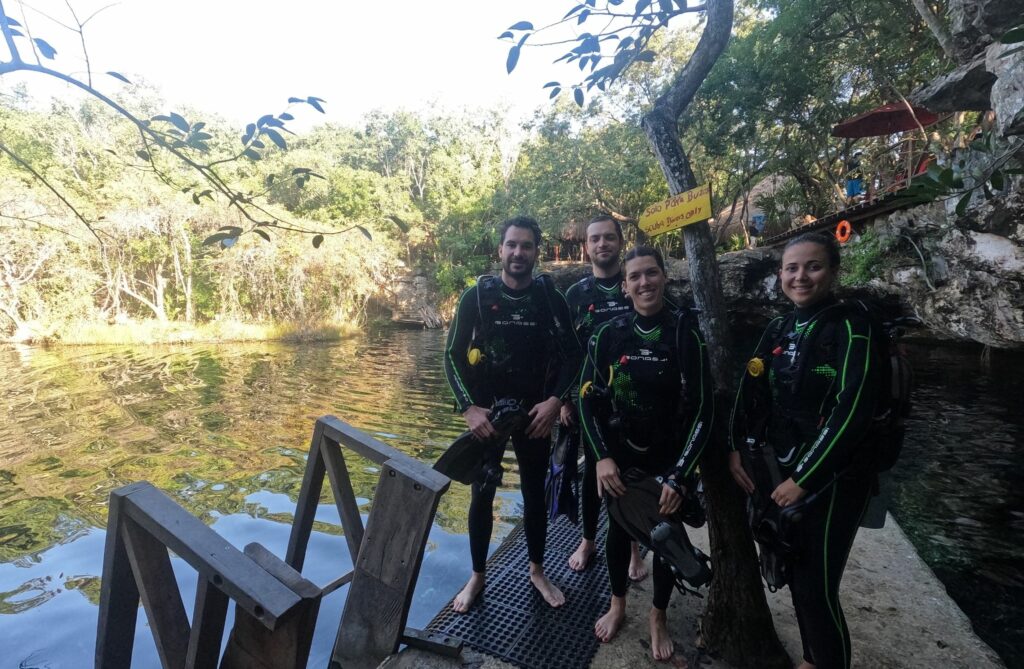
They often look like natural lakes surrounded by tropical vegetation. Their depth varies, but their brightness and accessibility make them perfect places for easy and relaxing dives.
Here are some well-known examples: Casa Cenote, Cenote Angelita, Cenote Jardin del Edén.
2. Semi-open cenotes
Semi-open cenotes keep part of their original ceiling, which creates stunning light effects, like in Cenote Chac Mool, where the darkness of the cave contrasts beautifully with the brightness outside.
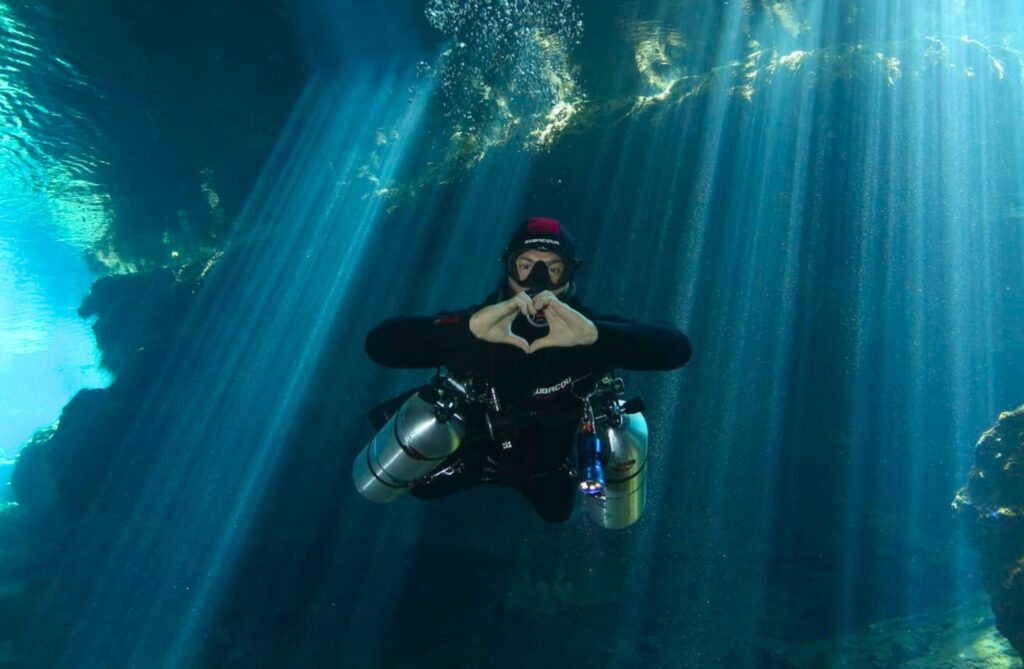
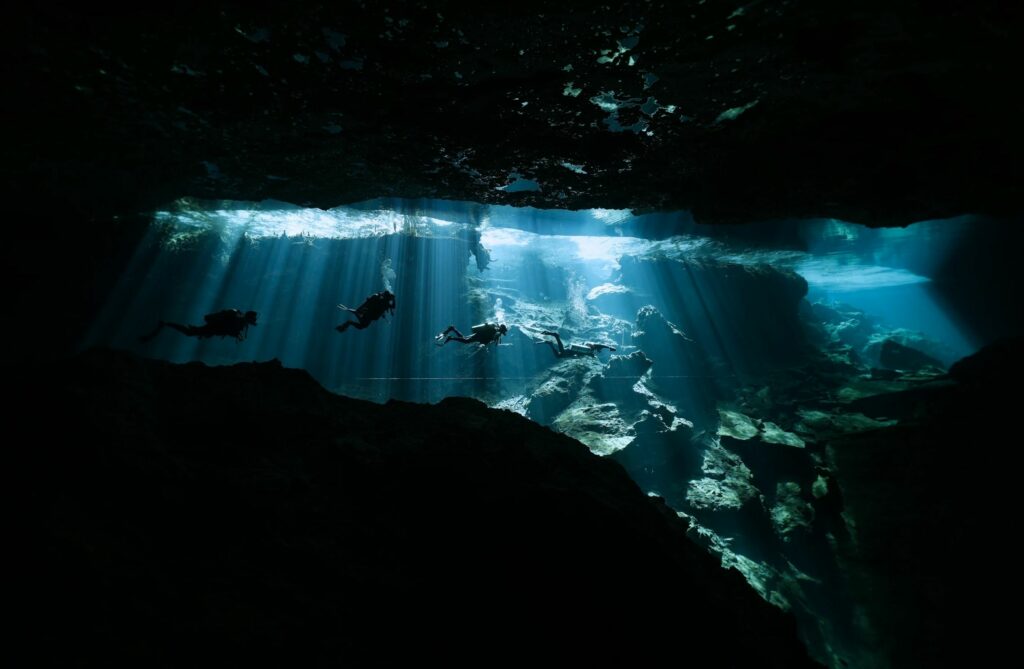
They offer a more mysterious atmosphere and are often perfect for diving or underwater photography.
3. Cave cenotes (or underground cenotes)
Cave cenotes are the youngest and most impressive from a geological point of view. Completely enclosed, they are located in underground passages where only artificial light illuminates the way.
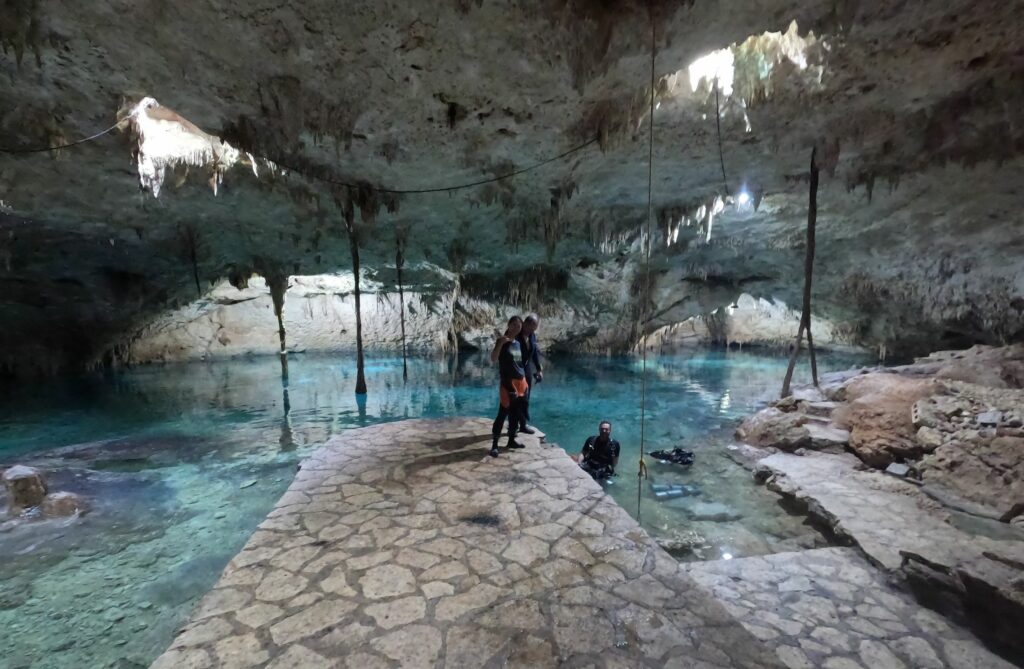
These sites are often reserved for certified divers due to their more technical environment and limited visibility.
They offer a unique experience in spectacular settings filled with stalactites and stalagmites. A well-known example is Dreamgate.
Where are most of the cenotes located in Mexico ?
Cenotes in Mexico are mainly found in the Yucatán Peninsula, a region known for its high concentration of these natural freshwater wells.
It is estimated that there are nearly 10,000 cenotes, although only a portion of them have been mapped and made accessible to the public.
What level do you need to dive in a cenote ?
Contrary to what many non-divers think, cenote diving is not only for experts or cave divers.
However, a minimum certification level is required for safety and experience reasons, and there are even a few cenotes where you can do your very first dive.
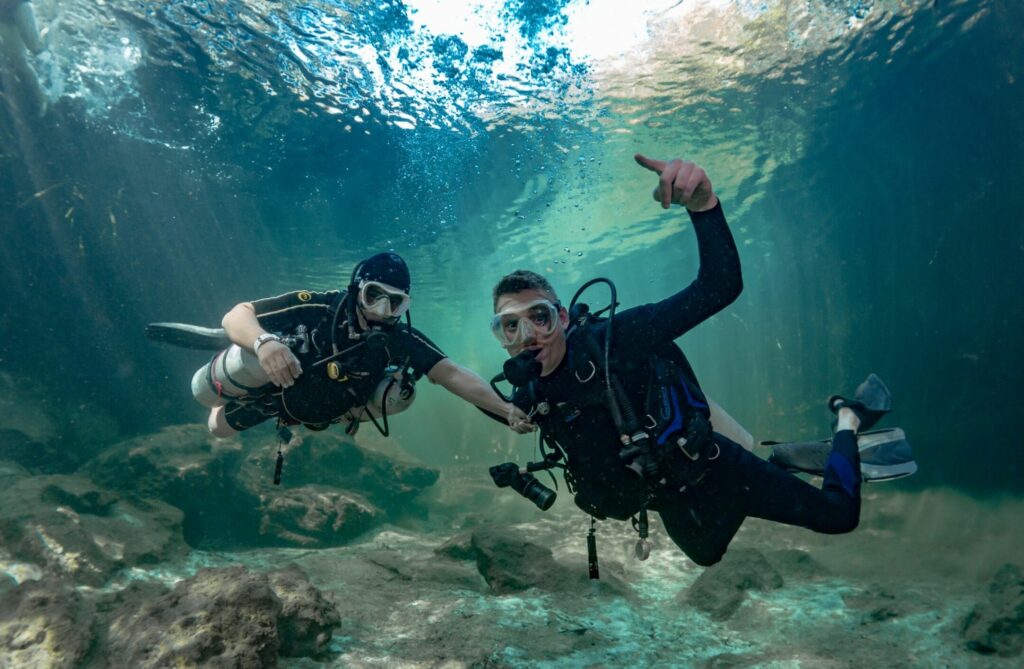
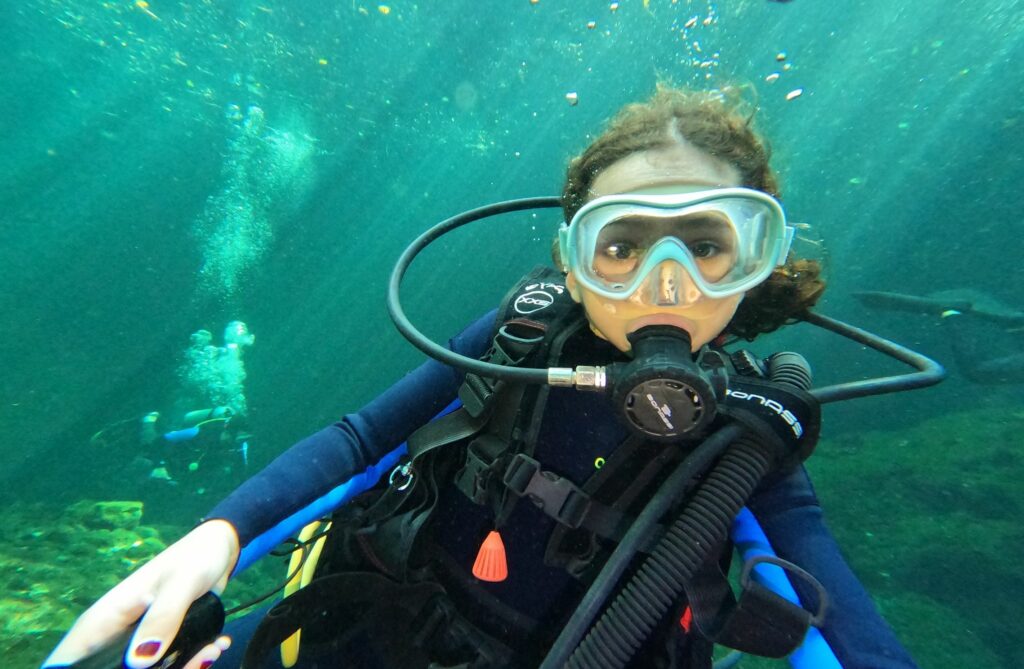
For most cenotes open to the public, an Open Water Diver certification (PADI, SSI, or equivalent) is enough. These dives usually take place in areas where natural light is still visible, without narrow passages or great depth.
If you have your Open Water certification and want to dive in a cenote, I highly recommend Cenote Dos Ojos and Cenote Chac Mool, two must visit sites for a first cenote diving experience.
What are the diving conditions in the cenotes of Mexico ?
Cenotes offer diving conditions that are unique in the world, very different from those of the ocean.
The water is fresh, calm, and exceptionally clear, often with visibility exceeding 40m. However, each cenote has its own characteristics depending on its depth, light, and structure.
Temperature in the cenotes
The water temperature in the cenotes of Mexico remains quite constant throughout the year, around 24 to 26°C. This allows for comfortable dives even outside the hot season.
Depth and configuration
The average depth of cenotes ranges between 5 and 20m, but some sites like Cenote The Pit can reach over 30 meters.
Each cenote has a different geological configuration. Some are open and bright, others are semi closed with spectacular light beams, and some are completely underground.
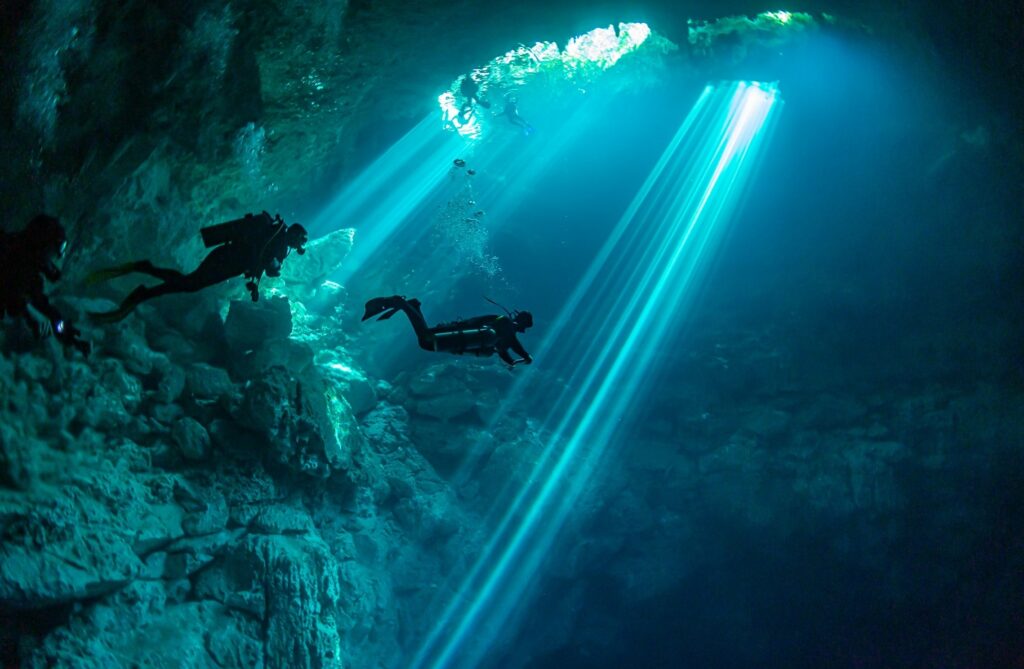
The conditions are generally calm, with no current or waves, allowing divers to fully focus on buoyancy and observing the rock formations.
Some sites feature a halocline, a transition zone between fresh and salt water, which creates a surprising visual effect typical of the cenotes in the Yucatán.
Visibility and light
Visibility in the cenotes is often exceptional, ranging from 30 to over 50m, thanks to the purity of the fresh water and the almost total absence of suspended particles. This clarity creates a unique feeling of weightlessness and allows divers to admire every detail of the rock formations.
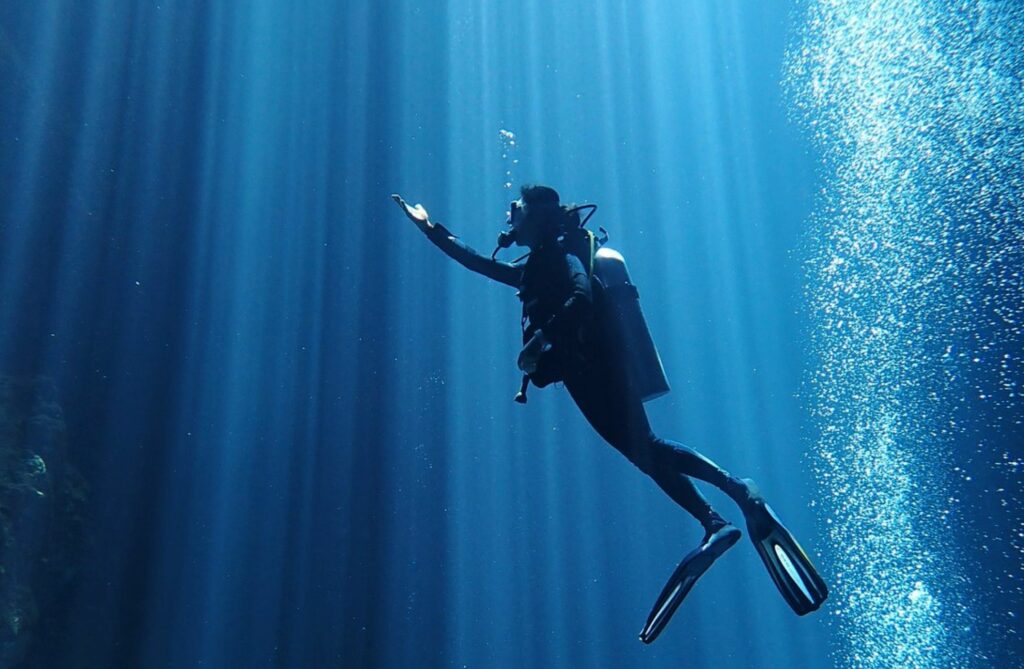
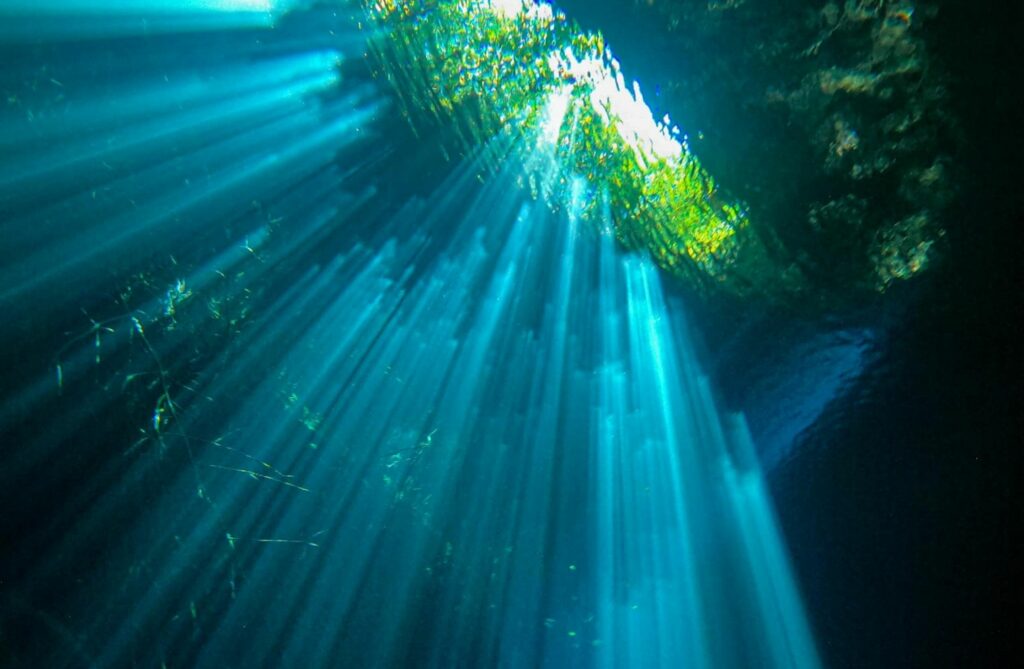
Light levels vary depending on the type of cenote. In open cenotes, natural light floods the entire cavity, creating a bright environment perfect for photography.
In semi open cenotes, light enters through openings at the surface, producing spectacular light effects that change throughout the day.
BONUS: The Halocline
The halocline is the zone where the fresh water from underground rivers meets the salt water rising from the sea. It is usually found between 10 and 20m deep, especially in cenotes located near the coast.
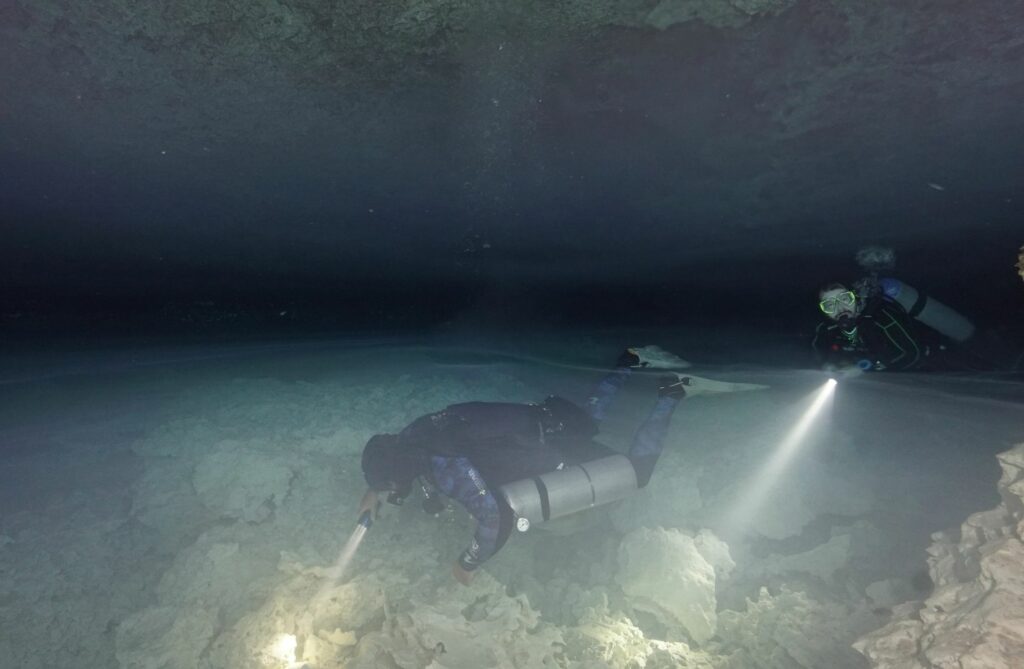
When you pass through it, visibility becomes blurry and the image distorts because of the difference in density between the two types of water.
This phenomenon can also come with a slight change in temperature. It creates an impressive visual effect typical of the cenotes in the Yucatán, but it requires good buoyancy control to avoid disturbing the layer.
What is the best season to dive in the cenotes ?
Cenote diving in Mexico is possible all year round, since as mentioned earlier, the water temperature stays stable around 24°C and the conditions are calm.
The dry season, from November to April, offers the best visibility and the most spectacular light effects, but it also attracts more divers.
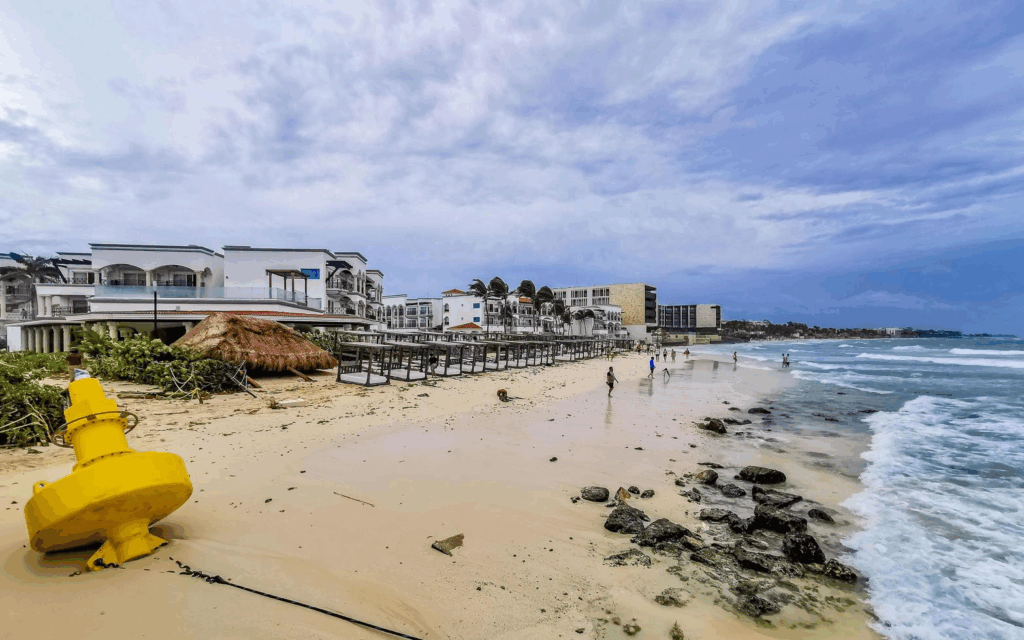
The rainy season, from May to October, is still enjoyable with fewer people and a more peaceful atmosphere, even though the light can be slightly reduced.
Each season has its own charm, with soft angled light in winter, vertical light beams in summer, and colorful reflections caused by tannins after the rains.
What marine life and vegetation can be observed in the cenotes ?
The cenotes of the Yucatán hide a fascinating underwater world. These are calm and mysterious places where nature has found a unique balance.
Each cenote is different.
Animal species
In the cenotes, you won’t find the colorful reef fish, but rather species that have adapted to living in darkness.
Some fish have lost their colors and even their eyes, such as the Poecilia mexicana.
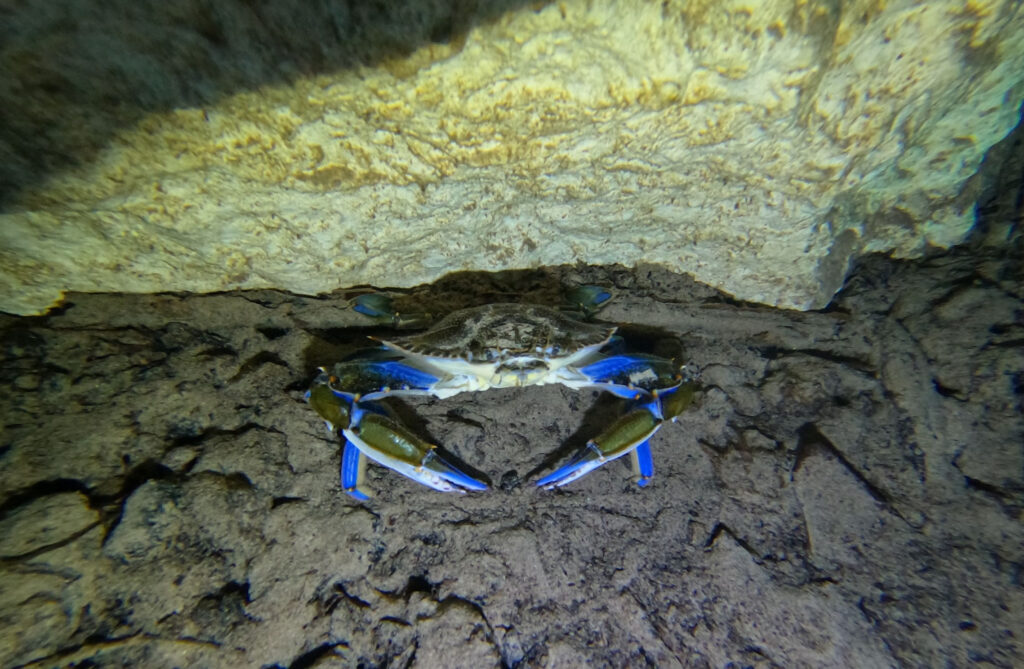
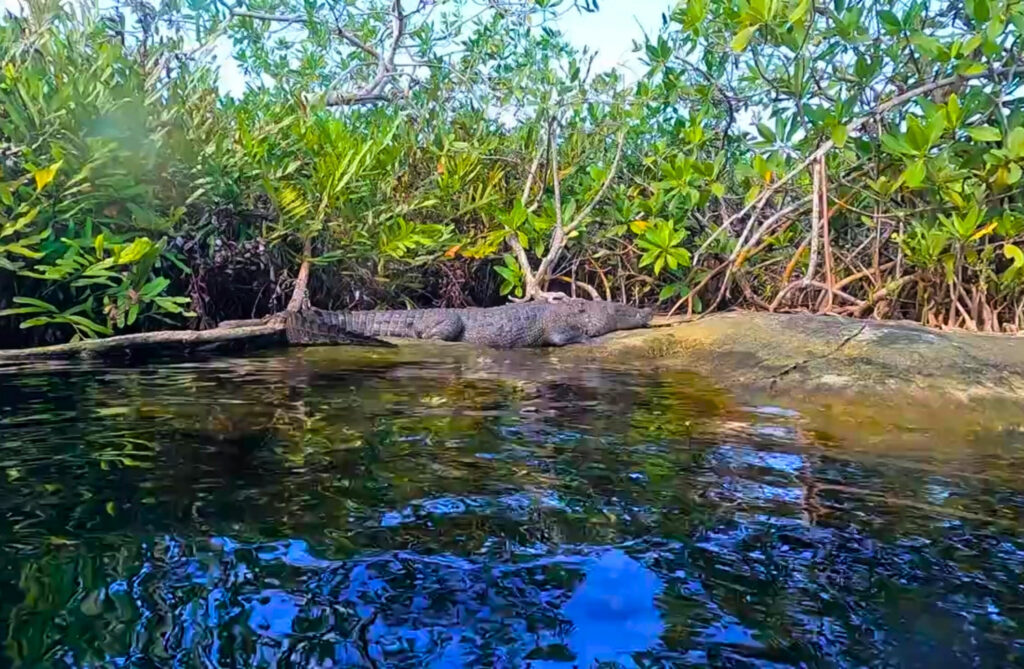
In the more open cenotes, you often encounter small freshwater fish, turtles, and at Casa Cenote, you might even spot Pancho, a well-known crocodile.
In the deeper passages, bats can also be found hanging from the ceiling, especially in Cenote Dos Ojos and Cenote Taak Bi Ha.
Geological formations
Cenotes are not only stunning because of their clear water, they are also true natural sculptures formed over time.
Inside, you can see stalactites hanging from the ceiling and stalagmites rising from the ground. These formations are created slowly, drop by drop, as water rich in limestone deposits thin layers of rock.
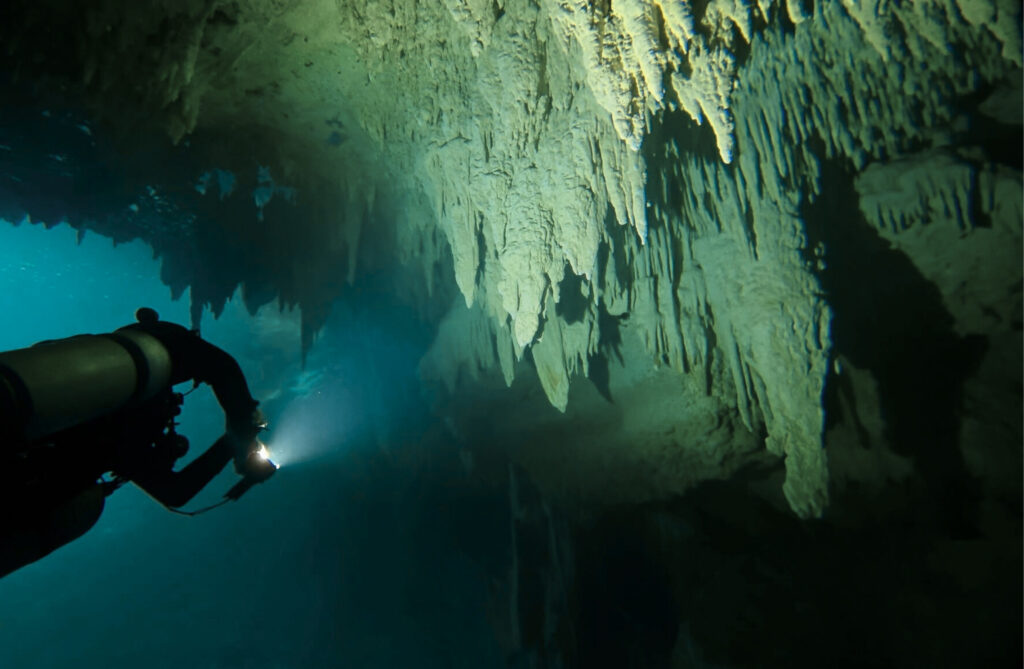
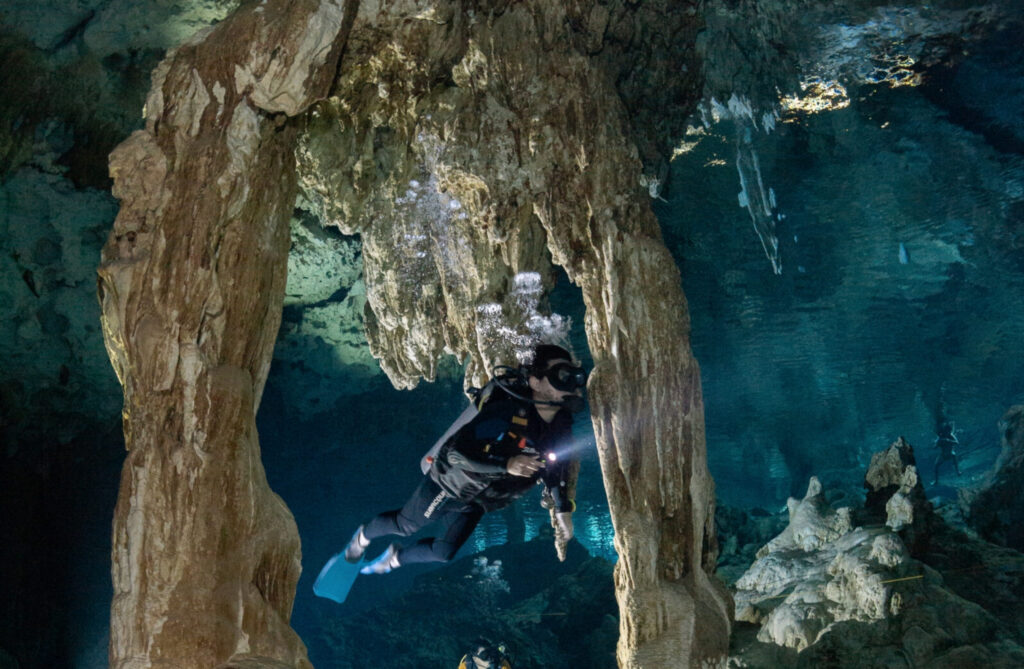
Avec les années, certaines finissent par se rejoindre pour former de grandes colonnes de pierre qui donnent aux cénotes l’apparence d’une grotte ou d’une cathédrale naturelle.
La lumière qui entre par les ouvertures se reflète alors sur les parois calcaires, créant des jeux de couleurs et une ambiance magique sous l’eau.
The 5 best cenote diving sites in Mexico
1. Cenote Chac Mool
Located near Playa del Carmen, Chac Mool is one of the most beautiful and accessible cenotes. An Open Water level is all you need to dive into its crystal clear water and admire the incredible light effects, especially when the sunlight passes through the natural openings.
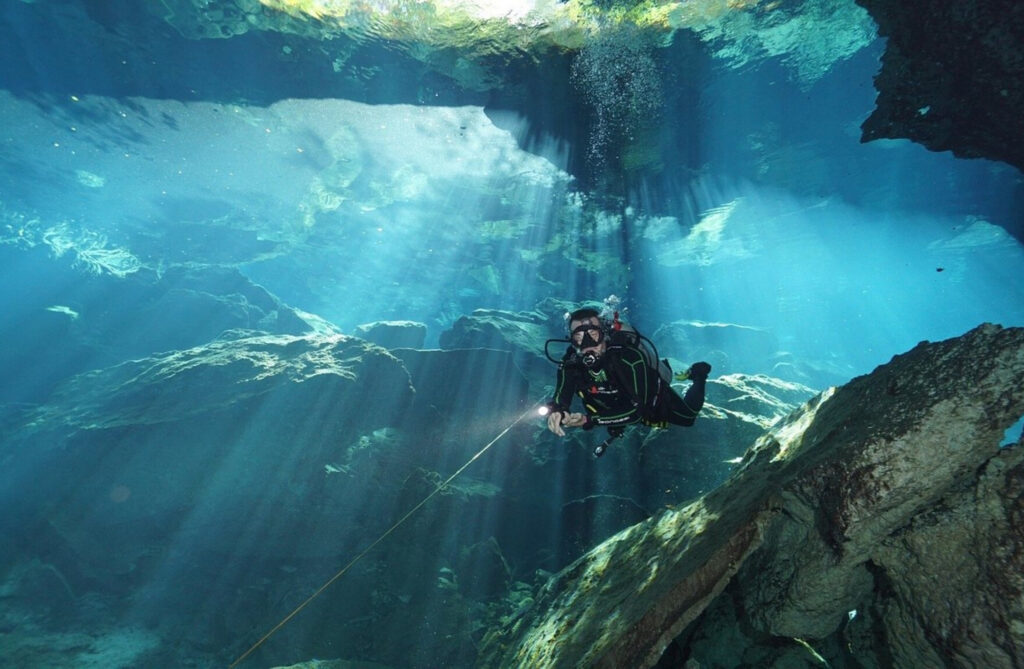
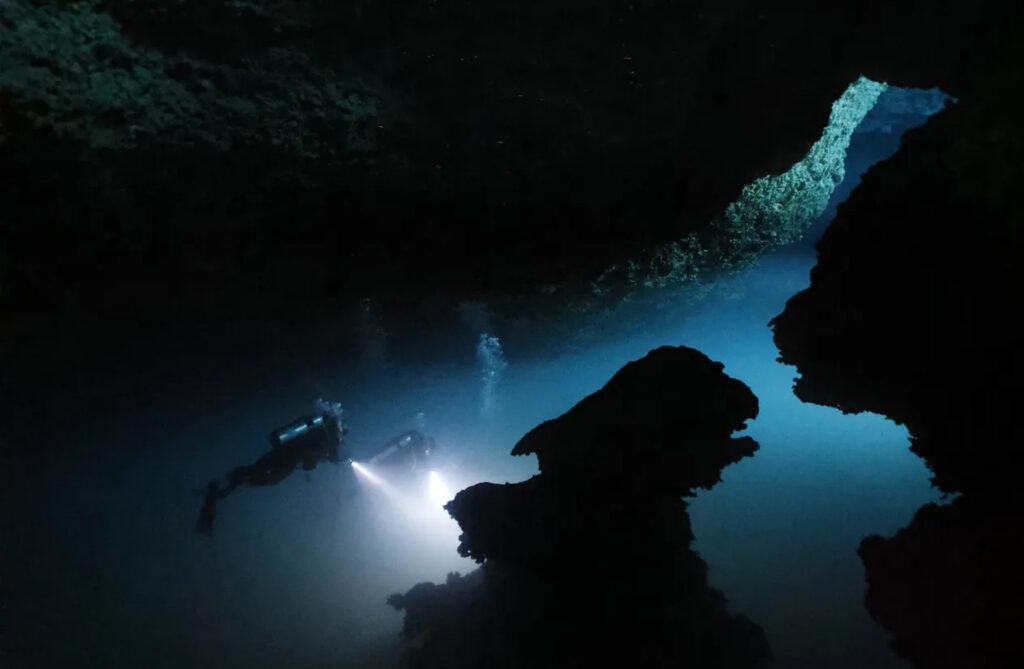
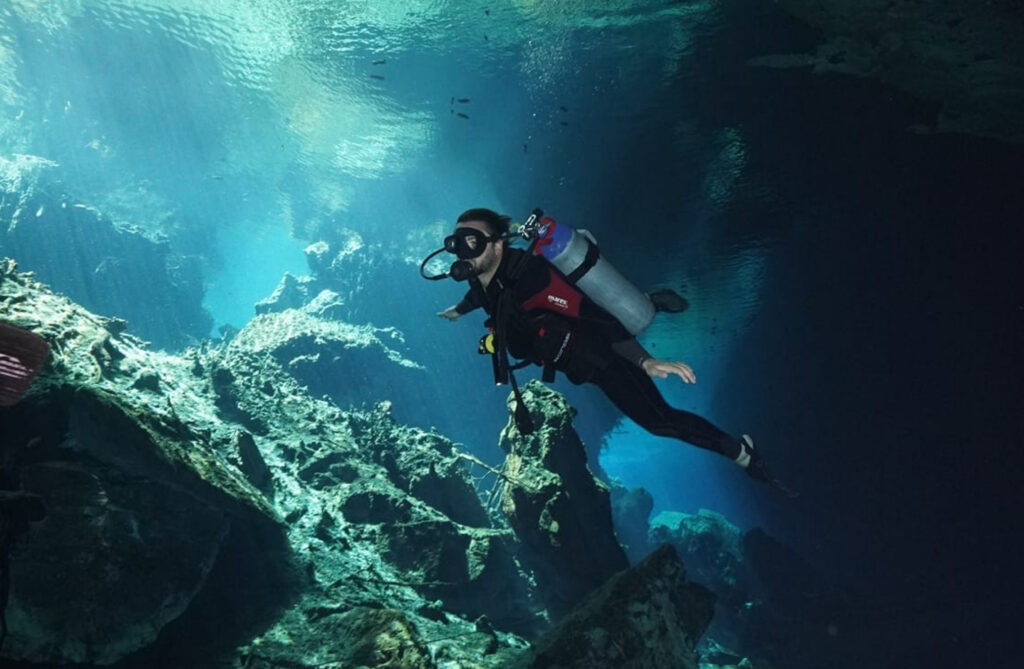
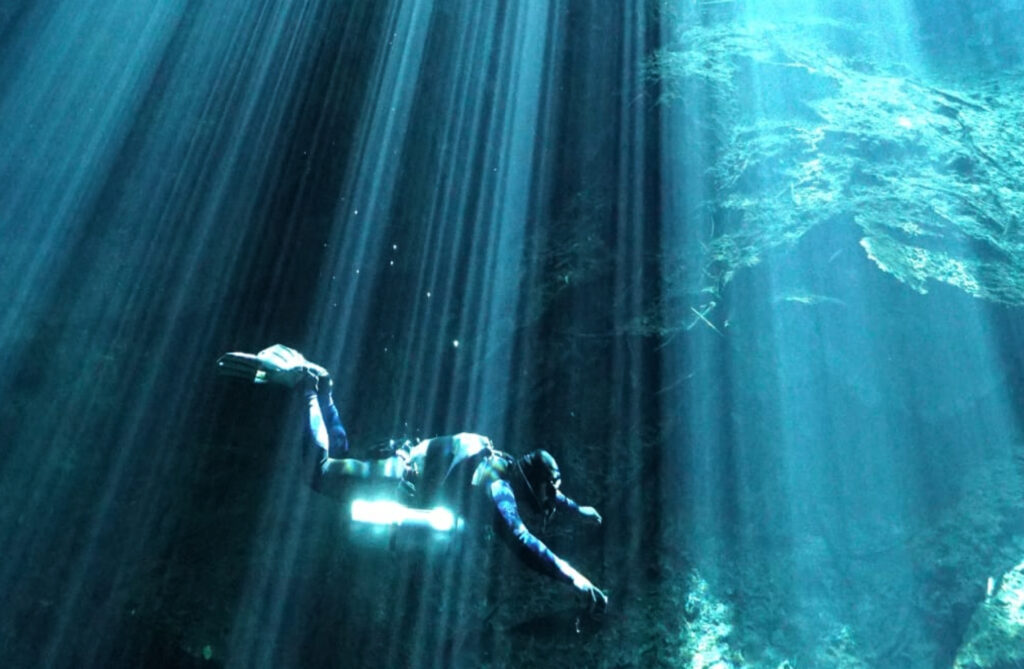
You can also observe a very distinct halocline there, the layer where fresh and salt water mix — a fascinating phenomenon for divers.
2. Cenote Dos Ojos
Probably the most famous cenote in Mexico, Dos Ojos (meaning “two eyes”) gets its name from its two main openings connected by a network of underwater tunnels. The water is incredibly clear, and the stalactites create an almost surreal setting.
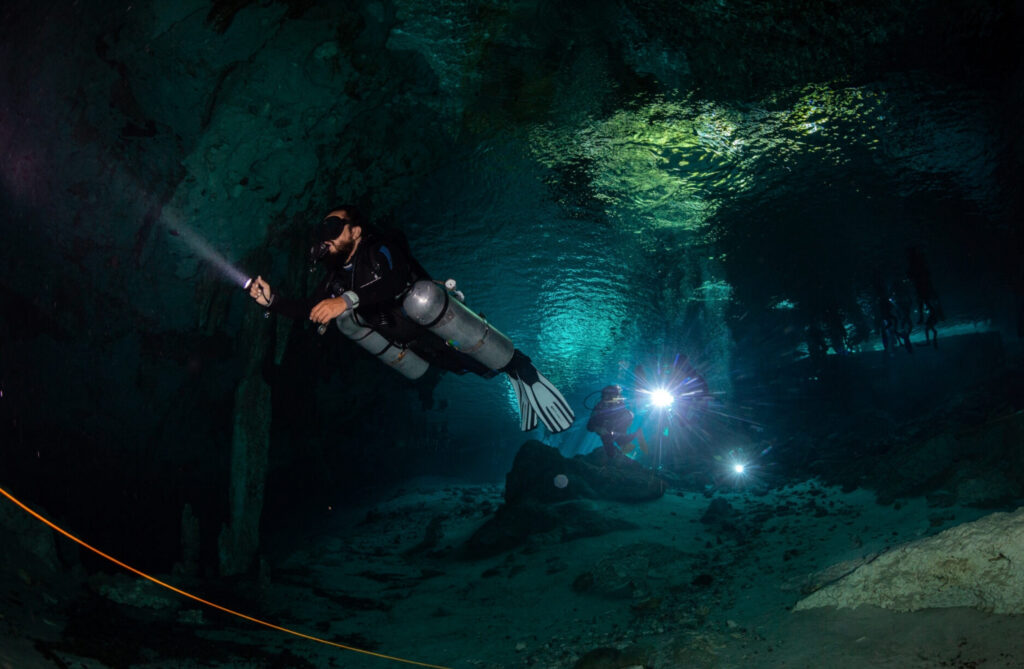
It’s a site I recommend visiting along with Cenote Chac Mool during a diving trip, as the experience is both magical and accessible.
3. Cenote The Pit
The Pit is a deep and spectacular cenote located in the same area as Dos Ojos. Its breathtaking descent into a cavity over 40m deep makes it a legendary site for experienced divers.
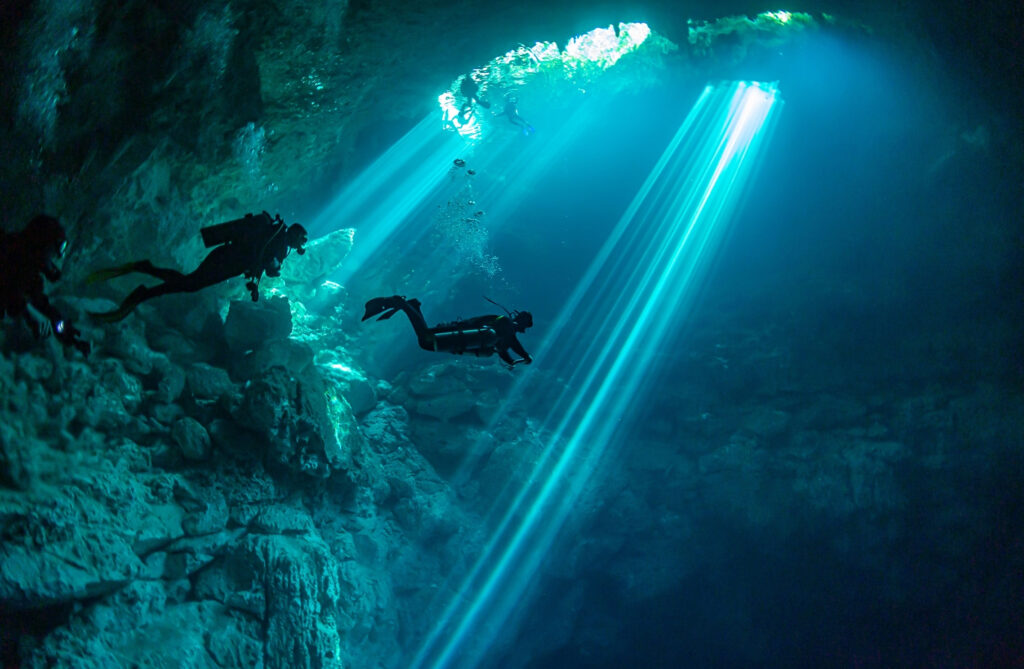
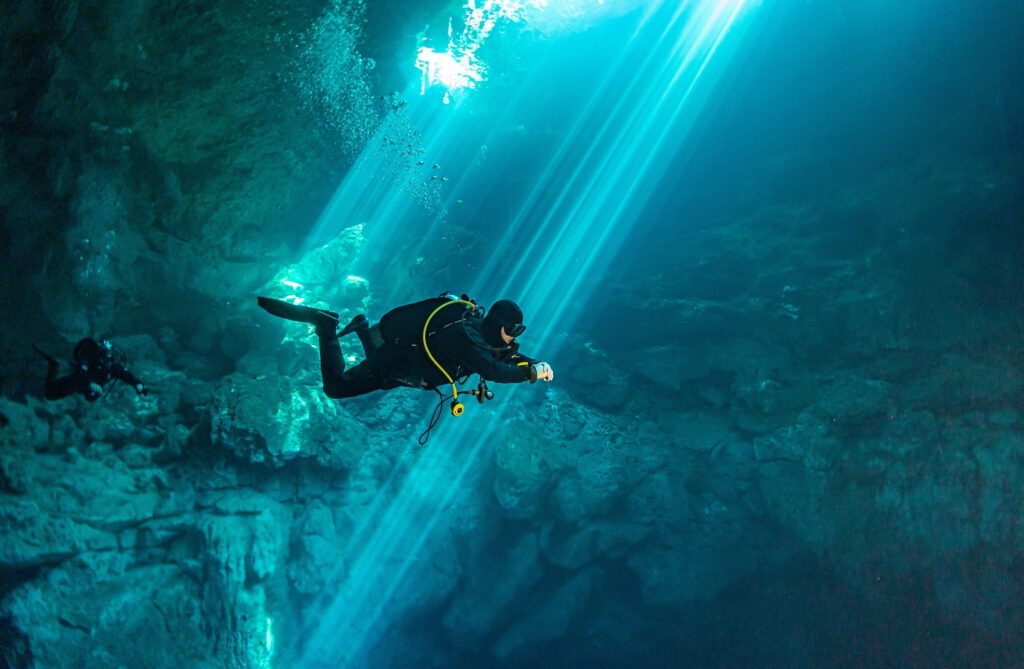
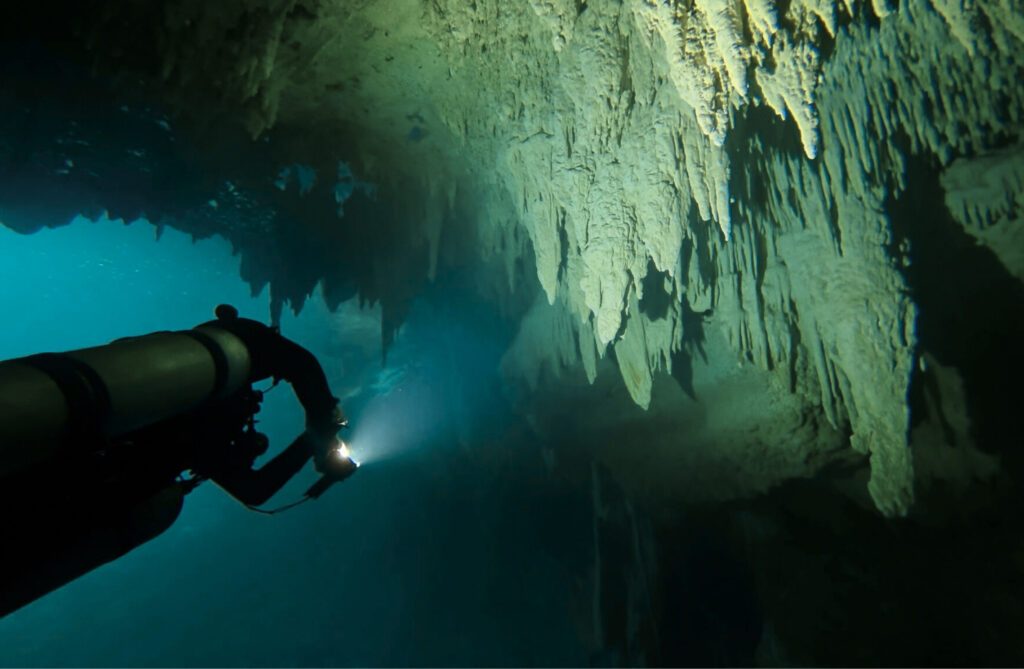
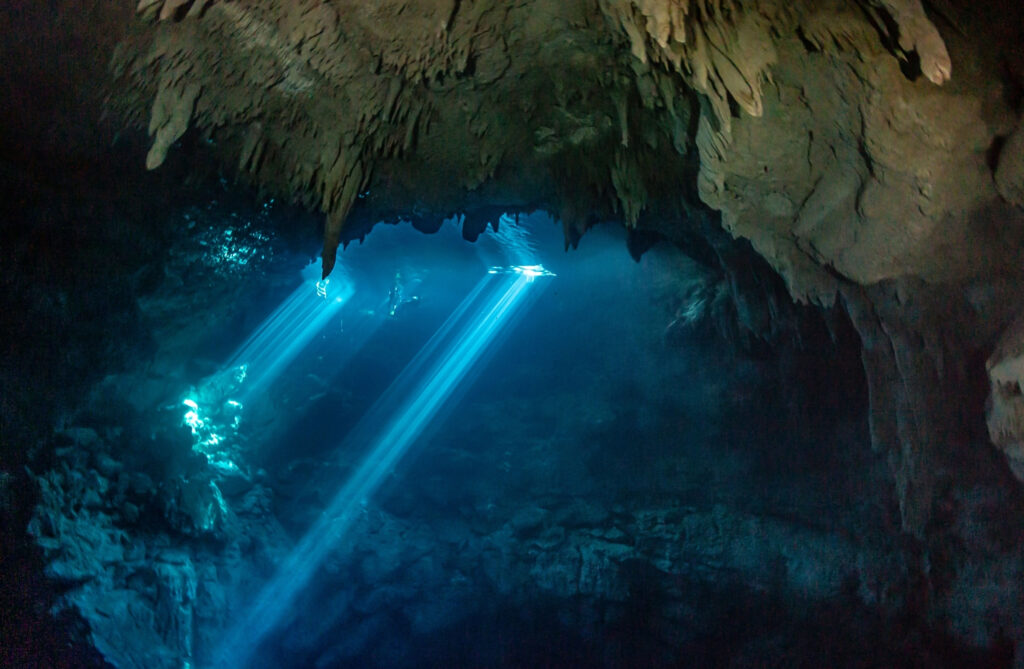
Sunlight pierces through the surface like a laser beam, creating a unique and mystical atmosphere. You can also observe a halocline and a thin layer of hydrogen sulfide around 30m deep.
4. Cenote Angelita
ChatGPT a dit :
Angelita is a very unique cenote, known for its famous layer of hydrogen sulfide that creates the illusion of an underwater river. This site is recommended for Advanced Open Water divers.
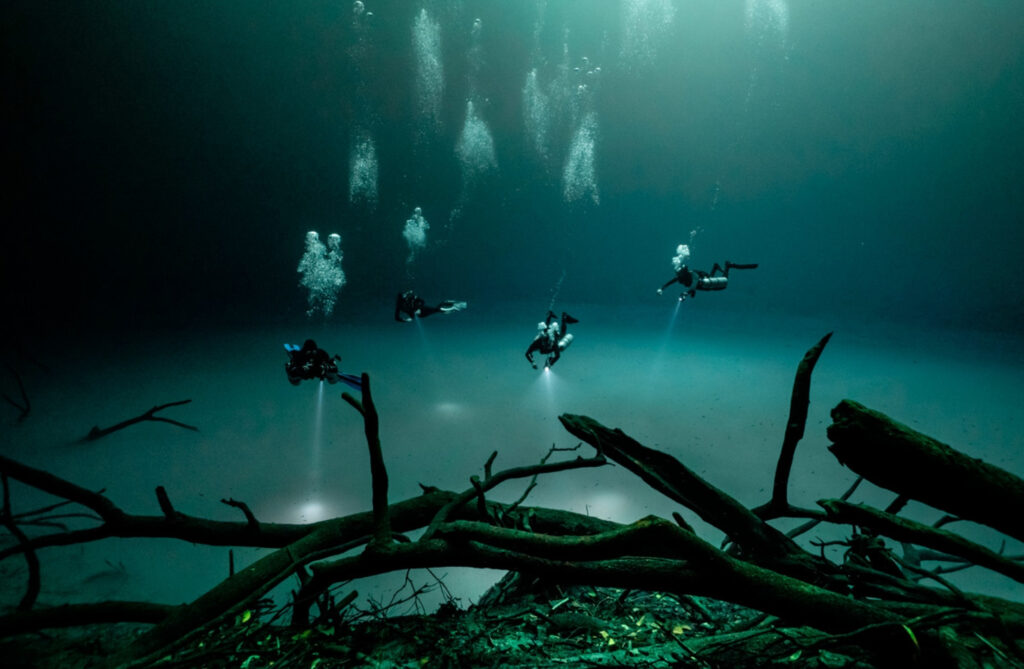
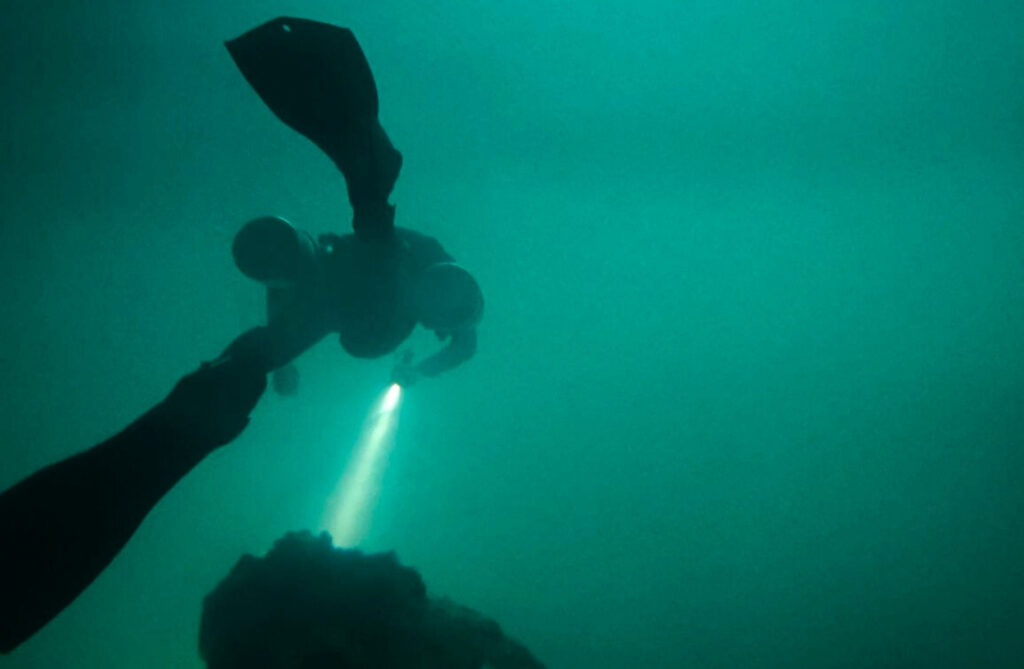
At around 30m deep, you literally dive into a milky mist before reappearing in a darker zone, giving the impression of a dreamlike scene.
5. Cenote Zapote
Cenote Zapote is a unique site known for its spectacular bell-shaped formations called “Hell Bells.” Located near Puerto Morelos, it offers a diving experience unlike any other cenote, with a dark and mysterious atmosphere.
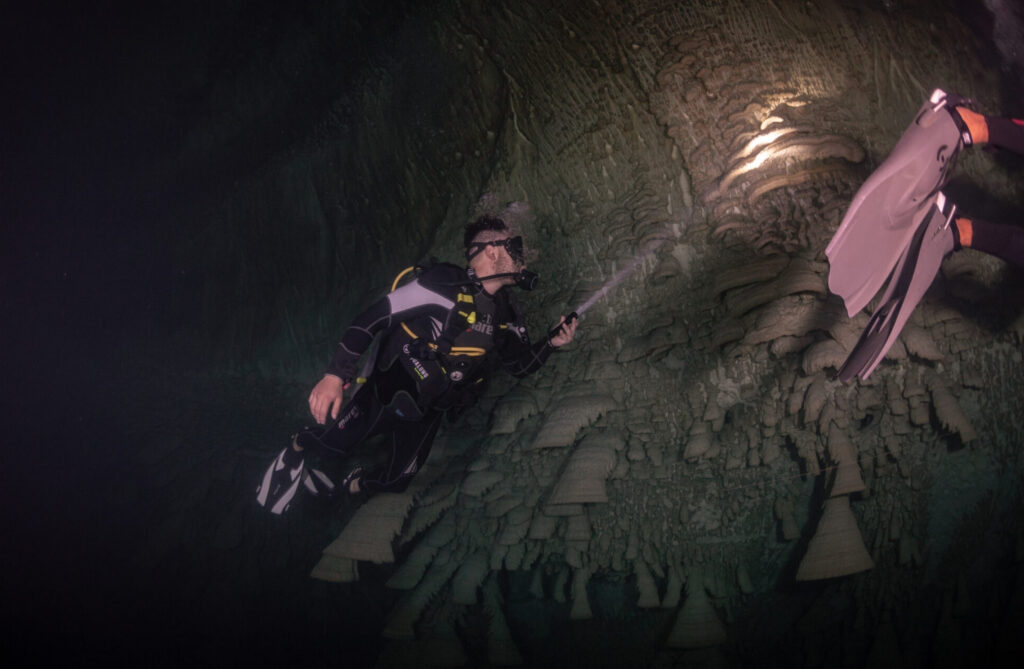
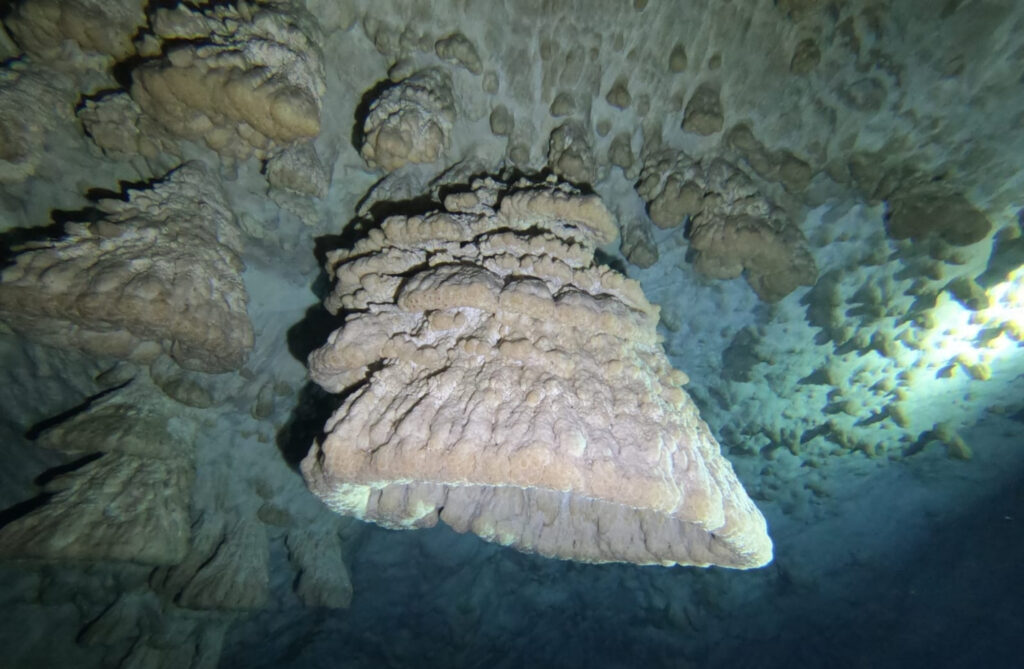
The descent takes you into a cavity about 35m deep, where these large suspended limestone formations give the feeling of entering another dimension. This cenote is recommended for experienced divers.
How much does a cenote dive cost ?
The price of a cenote dive in the Riviera Maya region usually ranges from around 3,200 MXN for a beginner dive to up to 3,800 MXN for a 2 cenote combo dive (about 240 to 290 US dollars).
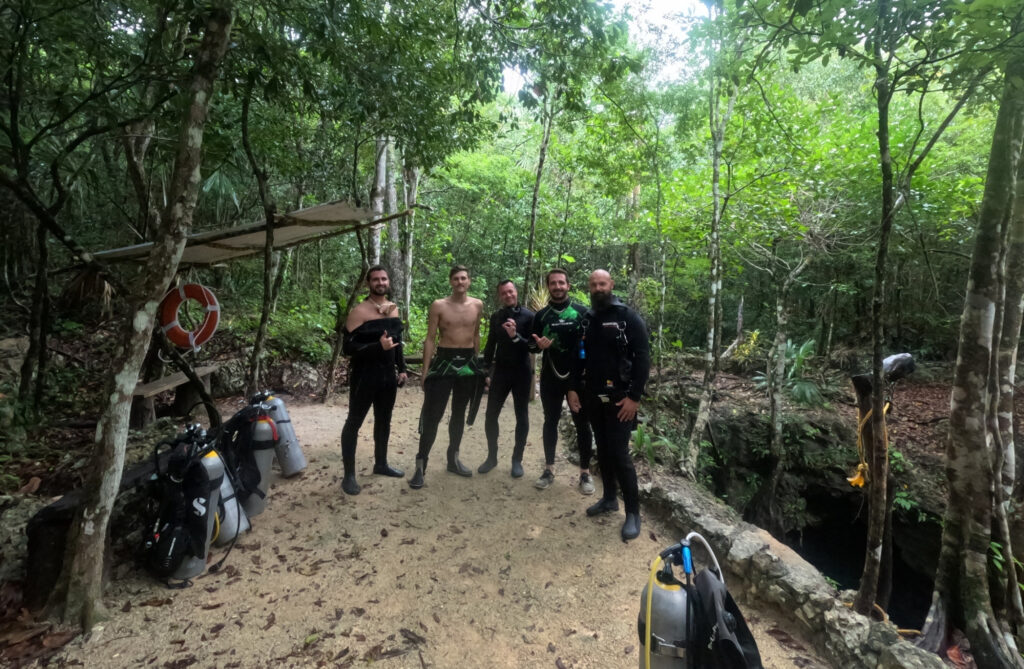
This price usually includes full equipment rental, the assistance of a certified guide, and sometimes transportation from Playa del Carmen.
The cost can vary depending on the cenote chosen, the services included (transportation, meals, supervision, photos, etc.), and the number of dives planned. Entrance fees are often added on top, ranging from 250 to 400 pesos depending on the site.
Which dive center should you choose to book your cenote dives ?
To fully enjoy the cenotes, it is important to choose an experienced dive center that regularly dives in cenotes.
Prioritize small groups because it is safer and more enjoyable. Also, check what is included in the price, as some offers include transportation and entrance fees, while others do not. Finally, a good dive center should have clear safety procedures and recent positive reviews from divers.
If you are looking for a reliable and well supervised experience, our passionate team is here to guide you.
